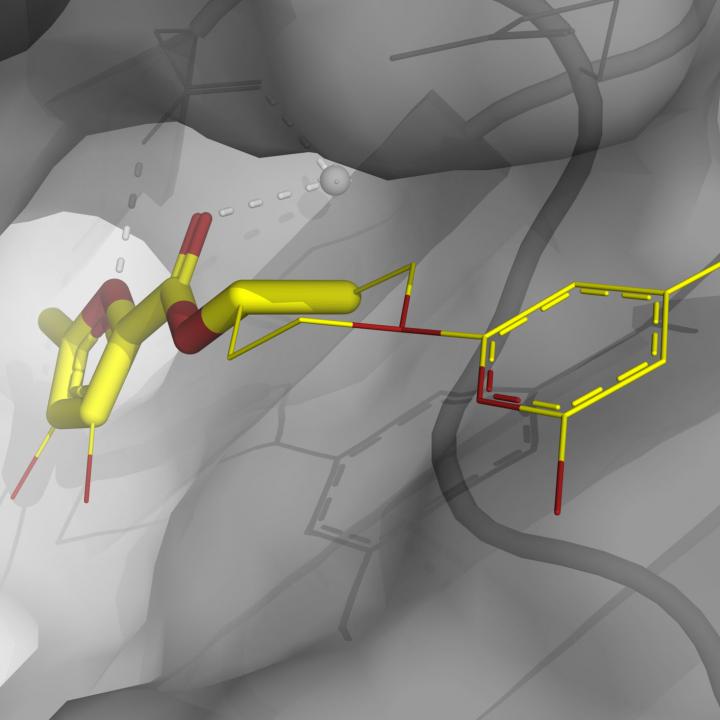Using fragment-based approaches to discover new antibiotics

Using fragment-based approaches to discover new antibiotics. Credit: Bas Lamoree and Roderick E. Hubbard
Authors Bas Lamoree and Roderick E. Hubbard of the University of York (UK) explain how FBLD works and illustrate its advantages over conventional high-throughput screening (HTS).
Specifically, how FBLD increases the chances of finding hit compounds; how its methods can deliver hits without the massive investment required for HTS; and how by starting small, FBLD gives medicinal chemists more opportunities to build more drug-like compounds.
These principles are illustrated in the review and supported with recent examples of discovery projects against a range of potential antibiotic targets.
The rise in antibiotic resistance is now recognized as a real threat to human health. However, no new antibiotics have been developed in many decades. FBLD begins by identifying low molecular weight compounds (fragments), which bind to protein targets. Information on how the fragments bind to their protein targets is then used to grow the compounds into potent drug candidates. Because the fragments are small, they are more likely to fit into a binding site and each fragment represents a huge number of potential compounds.
###
Using Fragment-Based Approaches to Discover New Antibiotics can be accessed for free at http://journals.
A PDF of this article is available to credentialed media outlets upon request. Contact nhallock@slas.org.
About our Society and Journals
SLAS (Society for Laboratory Automation and Screening) is an international community of nearly 20,000 professionals and students dedicated to life sciences discovery and technology. The SLAS mission is to bring together researchers in academia, industry and government to advance life sciences discovery and technology via education, knowledge exchange and global community building.
SLAS DISCOVERY: 2016 Impact Factor 2.444. Editor-in-Chief Robert M. Campbell, Ph.D., Eli Lilly and Company, Indianapolis, IN (USA). SLAS Discovery (Advancing Life Sciences R&D) was previously published (1996-2016) as the Journal of Biomolecular Screening (JBS).
SLAS TECHNOLOGY: 2016 Impact Factor 2.850. Editor-in-Chief Edward Kai-Hua Chow, Ph.D., National University of Singapore (Singapore). SLAS Technology (Translating Life Sciences Innovation) was previously published (1996-2016) as the Journal of Laboratory Automation (JALA).
Follow SLAS on Twitter at @SLAS_Org.
Follow SLAS on Facebook at SocietyforLaboratoryAutomationandScreening.
Follow SLAS on YouTube at SLASvideo.
Follow SLAS Americas on LinkedIn at Society for Laboratory Automation and Screening (SLAS Americas).
Follow SLAS Europe on LinkedIn at Society for Laboratory Automation and Screening Europe (SLAS Europe).
Media Contact
More Information:
http://dx.doi.org/10.1177/2472555218773034All latest news from the category: Health and Medicine
This subject area encompasses research and studies in the field of human medicine.
Among the wide-ranging list of topics covered here are anesthesiology, anatomy, surgery, human genetics, hygiene and environmental medicine, internal medicine, neurology, pharmacology, physiology, urology and dental medicine.
Newest articles

Superradiant atoms could push the boundaries of how precisely time can be measured
Superradiant atoms can help us measure time more precisely than ever. In a new study, researchers from the University of Copenhagen present a new method for measuring the time interval,…

Ion thermoelectric conversion devices for near room temperature
The electrode sheet of the thermoelectric device consists of ionic hydrogel, which is sandwiched between the electrodes to form, and the Prussian blue on the electrode undergoes a redox reaction…

Zap Energy achieves 37-million-degree temperatures in a compact device
New publication reports record electron temperatures for a small-scale, sheared-flow-stabilized Z-pinch fusion device. In the nine decades since humans first produced fusion reactions, only a few fusion technologies have demonstrated…





















